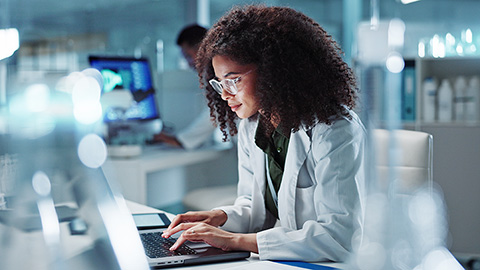Wait, Ph.D.s are free? And other things they don’t tell you
Working toward a Ph.D. in the biomedical sciences in a way is like moving to a new planet and trying to do scientific research there. The research is hard, of course, but so is learning how this new planet functions — the language, rules and culture. And people don’t always tell you that stuff; they just expect you to jump in and do a good job on your research.
So this week I wanted to begin to address the little secrets, the unspoken rules, the things you’re expected to know and do that aren’t necessarily spelled out clearly.
I’ve organized them into two groups: things that can be useful to know before you apply to a Ph.D. program, including while you are an undergrad, and things that can be useful to know when you start a Ph.D. program.
Today I’ll focus on the first group.

A STEM Ph.D. in the U.S. is usually funded.
This means that you don’t have to pay tuition. The institution still charges you tuition, but your principal investigator (PI) — the professor running the lab you’re in — pays the school for your tuition using their grants.
In fact, you will get paid, like you would at a job, for doing your Ph.D. research. Your pay can come from your PI’s grants, a departmental training grant, or from funds set aside for teaching assistants (if you get a TA position).
In later years of your Ph.D., you might get funding by applying for your own grants. Different schools have different policies about how long they guarantee funding, but it’s virtually unheard of for someone working toward a STEM Ph.D. to not be paid in some way.
A STEM master’s degree in the U.S. is usually not funded.
You typically have to pay tuition for those. The one exception is if you drop out of your Ph.D. program after you have gotten your master’s (more on this in the second part of this series). But the policy on this varies from school to school because it is not an ideal situation for the school to have students dropping out to get free master’s degrees.
You don’t usually need a master’s to do a STEM Ph.D. in the U.S.
You can usually apply straight to a Ph.D. program from undergrad without doing a master’s first. In other countries, this isn’t always the case. In the U.S., you do typically get a master’s along the way, sometimes even two. After you complete your coursework and pass your qualifying exam is a common spot to be awarded a master’s during your Ph.D. program.
The department you apply to might matter more than the school you choose.
Departments often have their own rules about what you need to do in order to graduate, as well as restrictions on which labs you can rotate into and work with.
Departments also have different styles and environments, with some being very close knit and others barely knowing each other.
These are the people who will really influence your life, so think about that when you’re applying.
Lab websites are often out of date.
I can’t even count how many times the info on a lab website I’ve looked at has turned out to be even decades out of date. PubMed is a better way to see what a lab is researching, unless you can tell the website is well maintained.
Getting into a program doesn’t always mean there is a lab for you.
It seems like getting into a graduate school should mean you can do your Ph.D. there. But in biomedical Ph.D. programs in the U.S., you usually are admitted to a program without having a specific lab committed to taking you (there are some exceptions). This means that during your rotations in your first year, you need to find a lab that will take you.
This is a hurdle that can occasionally and frustratingly lead to students dropping out. Consider carefully where you choose to rotate, and definitely find out if the lab has funding to take a student. It may feel awkward to ask that, but it is OK!
If a big part of your decision to go to a certain school is one particular PI you hope to work with, make sure you have talked to them and the department you are applying to, and confirm you can join that lab.
As an undergrad, see if a professor at your school or a nearby school will let you work in their lab.
You can literally just email them and ask.
Summer programs exist too so that undergrads can get research experience. Then you can figure out if you like research without devoting your life to it first. And it will also help you get into grad school. (See the ASBMB job board for internships.)
Postbac and bridge programs exist.
If you think you want to go to grad school but haven’t had the opportunity to work in a lab and get enough experience, you can try a postbac or bridge program. These are programs aimed at preparing students, especially underrepresented minorities, for grad school. Here are some examples.
Just know that these programs can cost money. ASBMB Today’s Laurel Oldach wrote about master’s degrees in February 2020. Black biologists are more likely than any other group to earn a master’s degree before entering a Ph.D. program, and that means they’re acquiring more debt. She reported on the factors that account for that disparity.
Stay tuned for the second part of this series, which will focus on information you need to know once you’re actually in grad school.
Enjoy reading ASBMB Today?
Become a member to receive the print edition four times a year and the digital edition monthly.
Learn moreFeatured jobs
from the ASBMB career center
Get the latest from ASBMB Today
Enter your email address, and we’ll send you a weekly email with recent articles, interviews and more.
Latest in Careers
Careers highlights or most popular articles

Designing life’s building blocks with AI
Tanja Kortemme, a professor at the University of California, San Francisco, will discuss her research using computational biology to engineer proteins at the 2026 ASBMB Annual Meeting.

Upcoming opportunities
#ASBMB26 late-breaking abstract submission opens on December 8. Register by Jan. 15 to get the early rate on our Annual Meeting.

Make your abstract stand out
Ensure your research is impossible to overlook. Get quick, practical reminders for crafting an abstract that attracts readers and helps you build connections at the conference.

Inside industry postdocs
As more Ph.D. scientists look beyond academia, industry postdocs offer a new kind of training, where mentorship meets mission-driven research. Fellows at Pfizer and Genentech share how these programs prepare them to translate discovery into impact.

Upcoming opportunities
The Lipid Research Division Seminar Series returns Oct. 15 with talks on recent advances in triglyceride cycling in adipocytes.

Writing with AI turns chaos into clarity
Associate professor shares how generative AI, used as a creative whiteboard, helps scientists refine ideas, structure complexity and sharpen clarity — transforming the messy process of discovery into compelling science writing.

